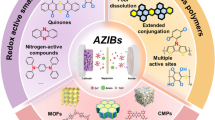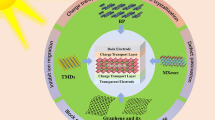Abstract
The effects of water-containing I−/I3− liquid electrolytes on the photovoltaic performance and long-term stability of ruthenium based complex Z907 dye was examined in dye-sensitized solar cells (DSSCs). Despite of high water content up to 60 vol% in organic solvent-based liquid electrolyte, the photovoltaic properties and long-term stability measured under the standard global (G) air-mass (AM) 1.5 solar irradiation were not significantly affected. The underlying correlation between the effects of water and the photovoltaic performances were identified by UV–visible spectroscopy and electrochemical impedance spectroscopy. We investigated the long-term stability of performance for DSSCs in conjunction with I−/I3− redox electrolytes in different water compositions. The findings revealed that the competitive photovoltaic performance and long-term stability of water-containing DSSCs mainly depends on the hydrophobicity of dye as well as the transport phenomena of I3− throughout the electrolytes. The water-based DSSCs proposed herein are free from water permeation issues and these results will provide great insight into the development of less expensive and more environmental friendly DSSCs.






Similar content being viewed by others
References
Smalley, R. E. (2005). Future global energy prosperity: The terawatt challenge. MRS Bulletin, 30(6), 412–417.
Choi, J.-H., Moon, Y., Lee, S.-H., In, J.-H., & Jeong, S. (2016). Wavelength dependence of the ablation characteristics of Cu (In, Ga) Se2 solar cell films and its effects on laser induced breakdown spectroscopy analysis. International Journal of Precision Engineering and Manufacturing-Green Technology, 3(2), 167–171.
O’Regan, B., & Grätzel, M. (1991). A low-cost, high-efficiency solar cell based on dye-sensitized colloidal TiO2 films. Nature, 353(6346), 737–740.
O’Regan, B., & Grätzel, M. (1991). A low-cost, high-efficiency solar cell based on dye-sensitized colloidal TiO2 films. Nature, 353(6346), 737–740.
Chang, H., Kuo, C.-G., & Chou, C.-Y. (2015). Highly-ordered arrays of TiO2 thin film for dye-sensitized solar cells fabricated by anodic oxidation process. International Journal of Precision Engineering and Manufacturing, 16(7), 1251–1255.
Kim, Y.-W., Kang, B.-S., & Lee, D.-W. (2015). Improving efficiency of dye-sensitized solar cell by micro reflectors. International Journal of Precision Engineering and Manufacturing, 16(7), 1257–1261.
Gong, H. H., Park, S. H., Lee, S.-S., & Hong, S. C. (2014). Facile and scalable fabrication of transparent and highperformance Pt/reduced graphene oxide hybrid counter electrode for dye-sensitized solar cells. International Journal of Precision Engineering and Manufacturing, 15(6), 1193–1199.
Mathew, S., Yella, A., Gao, P., Humphry-Baker, R., Curchod, B. F., Ashari-Astani, N., et al. (2014). Dye-sensitized solar cells with 13% efficiency achieved through the molecular engineering of porphyrin sensitizers. Nature Chemistry, 6(3), 242–247.
Komiya, R., Fukui, A., Murofushi, N., Koide, N., Yamanaka, R., & Katayama, H. (2011). Improvement of the conversion efficiency of a monolithic type dye-sensitized solar cell module. In Technical Digest of the 21st International Photovoltaic Science and Engineering Conference, 2C-5O-08, Fukuoka, Japan.
Nazeeruddin, M. K., De, A. F., Fantacci, S., Selloni, A., Viscardi, G., Liska, P., et al. (2005). Combined experimental and DFT-TDDFT computational study of photoelectrochemical cell ruthenium sensitizers. Journal of the American Chemical Society, 127(48), 16835–16847.
Cao, Y. M., Bai, Y., Yu, Q. J., Cheng, Y. M., Liu, S., Shi, D., et al. (2009). Dye-sensitized solar cells with a high absorptivity ruthenium sensitizer featuring a 2-(hexylthio)thiophene conjugated bipyridine. Journal of Physical Chemistry C, 113(15), 6290–6297.
Muhammad, I. A., Kati, M., Janne, H., Paula, V., Minna, T., Kerttu, A., et al. (2010). Review of stability for advanced dye solar cells. Energy & Environmental Science, 3(4), 418–426.
Egbert, F., & Anders, H. (2004). Are dye-sensitized nano-structured solar cells stable? An overview of device testing and component analyses. International Journal of Photoenergy, 6(3), 127–140.
Law, C., Pathirana, S. C., Li, X., Anderson, A. Y., Barnes, P. R., Listorti, A., et al. (2010). Water-based electrolytes for dye-sensitized solar cells. Advanced Materials, 22(40), 4505–4509.
Yelena, G. T., & Noel, G. H. (1997). Activated rate theory treatment of oxygen and water transport through silicon oxide/poly(ethylene terephthalate) composite barrier structures. Journal of Physical Chemistry, 101(13), 2259–2266.
Wang, P., Zakeeruddin, S. M., Moser, J. E., Nazeeruddin, M. K., Sekiguchi, T., & Grätzel, M. (2003). A stable quasi-solid-state dye-sensitized solar cell with an amphiphilic ruthenium sensitizer and polymer gel electrolyte. Nature Materials, 2(7), 498–498.
Ito, S., Murakami, T. N., Comte, P., Liska, P., Graetzel, C., Nazeeruddin, M. K., et al. (2008). Fabrication of thin film dye sensitized solar cells with solar to electric power conversion efficiency over 10%. Thin Solid Films, 516(14), 4613–4619.
Park, S.-J., Yoo, K., Kim, J.-Y., Kim, J.-Y., Lee, D.-K., Kim, B., et al. (2013). Water-based thixotropic polymer gel electrolyte for dye-sensitized solar cells. ACS Nano, 7(5), 4050–4056.
Mikoshiba, S., Murai, S., Sumino, H., Kado, T., Kosugi, D., & Hayase, S. (2005). Ionic liquid type dye-sensitized solar cells: Increases in photovoltaic performances by adding a small amount of water. Current Applied Physics, 5(2), 152–158.
Liu, Y., Hagfeldt, A., Xiao, X. R., & Lindquist, S. E. (1998). Investigation of influence of redox species on the interfacial energetics of a dye-sensitized nanoporous TiO2 solar cell. Solar Energy Materials Solar Cells, 55(3), 267–281.
Weidmann, J., Dittrich, T., Konstantinova, E., Lauermann, I., Uhlendorf, I., & Koch, F. (1999). Influence of oxygen and water related surface defects on the dye sensitized TiO2 solar cell. Solar Energy Materials Solar Cells, 56(2), 153–165.
Hahlin, M., Johansson, E. M. J., Scholin, R., Siegbabn, H., & Rensmo, H. (2011). Influence of water on the electronic and molecular surface structures of ru-dyes at nanostructured TiO2. Journal of Physical Chemistry C, 115(24), 11996–12004.
Yang, Y., Zhang, J., Zhou, C. H., Wu, S. J., Xu, S., Liu, W., et al. (2008). Effect of lithium iodide addition on poly (ethylene oxide)−poly (vinylidene fluoride) polymer-blend electrolyte for dye-sensitized nanocrystalline solar cell. Journal of Physical Chemistry B, 112(21), 6594–6602.
Fabregat-Santiago, F., Bisquert, J., Garcia-Belmonte, G., Boschloo, G., & Hagfeldt, A. (2005). Influence of electrolyte in transport and recombination in dye-sensitized solar cells studied by impedance spectroscopy. Solar Energy Materials Solar Cells, 87(1–4), 117–131.
Park, J., Choi, I., Lee, M.-J., Kim, M.-H., Lim, T., Park, K.-H., et al. (2014). Effect of fluoroethylene carbonate on electrochemical battery performance and the surface chemistry of amorphous MoO2 lithium-ion secondary battery negative electrodes. Electrochimica Acta, 132, 338–346.
Wyss, P., Moehl, T., Zakeeruddin, S. M., & Grätzel, M. (2012). Influence of cations of the electrolyte on the performance and stability of dye sensitized solar cells. Journal of Materials Chemistry, 22(46), 24424–24429.
Pan, L., Zou, J. J., Zhang, X. W., & Wang, L. (2011). Water-mediated promotion of dye sensitization of TiO2 under visible light. Journal of the American Chemical Society, 133(26), 10000–10002.
Park, S. I., Quan, Y.-J., Kim, S.-H., Kim, H., Kim, S., Chun, D.-M., et al. (2016). A review on fabrication processes for electrochromic devices. International Journal of Precision Engineering and Manufacturing-Green Technology, 3(4), 397–421.
Acknowledgement
Authors acknowledge the funding support by development program “Development of high drapability of textile type dye-sensitized solar cell materials and outdoor applications. (project NO. 10052064)” funded by MOTIE and the Technology Development Program to Solve Climate Changes (2015M1A2A2056824) funded by the National Research Foundation under the Ministry of Science an ICT, Korea.
Author information
Authors and Affiliations
Corresponding authors
Additional information
Publisher’s Note
Springer Nature remains neutral with regard to jurisdictional claims in published maps and institutional affiliations.
Rights and permissions
About this article
Cite this article
Park, J., Lee, P. & Ko, M. Design and Fabrication of Long-Term Stable Dye-Sensitized Solar Cells: Effect of Water Contents in Electrolytes on the Performance. Int. J. of Precis. Eng. and Manuf.-Green Tech. 6, 125–131 (2019). https://doi.org/10.1007/s40684-019-00025-4
Received:
Revised:
Accepted:
Published:
Issue Date:
DOI: https://doi.org/10.1007/s40684-019-00025-4




